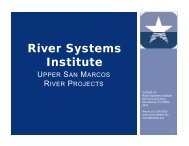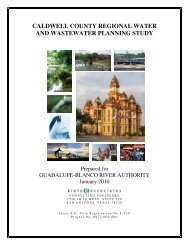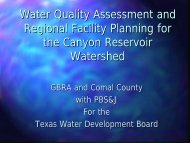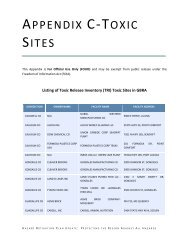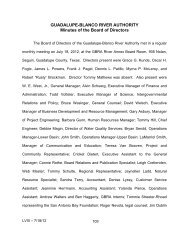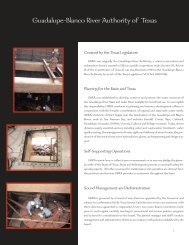Water Drama of Epic Propthat originated in the House years ago, which would have chargedhome and business owners annual fees for water, never got out ofthe House, said Rep. Allan Ritter, R-Nederland, chair of the HouseNatural Resources Committee, speaking at a public water forumhosted by the Texas Tribune, a nonprofit media organization.Now planners and legislators are pinning their hopes on the2013 legislative session to tackle some of the $53 billion inprojects in the <strong>2012</strong> Water Plan. “Regional entities are asking forabout $27 billion in assistance,” Brittin said. She stresses thatno one is asking for the state to pay for $27 billion in projects.“They are asking for interest subsidies for which the local entitieswould pay back the whole ofthe capital and most of theinterest.”Projects requiring TWDBhelp sometimes work this way:A city, county, or river authorityunable to absorb the full debt of a project may apply for waterproject funds through a State Participation Program. This programgives the TWDB temporary ownership interest in the projectby assuming most of the debt. TWDB must obtain legislativeapproval before issuing the bonds. If a project is approved, theentities move ahead and repay the debt on a deferred timetable,The TWDB has approved a $4.4 million loan for a GBRAfeasibility study to identify surface and groundwater supplies andtransmission delivery options. That proposal awaits legislativeapproval before going forward.Population pressures and fundingThe <strong>2012</strong> State Water Plan noted that the population of Texasincreased more than 20 percent between 2000 and 2010. Thatgrowth was not distributed evenly. For example, although some ofthe state’s 254 counties have less population now than they did in2000, others have grown more than 80 percent.Sudden growth isa challenge for anyentity that serves thepublic. Because almost55 percent of Texansrely on groundwaterfor drinking, droughtslike the last one are a big concern, especially since the droughtcontinues to affect the largest population areas even today. Forexample, the Edwards Aquifer, which comprises about 95 percentof San Antonio’s drinking water, fell to a level at its J-17 well ofabout 648 feet in mid-November <strong>2012</strong>. The long-term averageelevation of J-17 is 664 feet.But we cannot solve this problem withconservation only or reallocation ofagriculture supplies to municipal areas.and no project has ever defaulted on its state-backed loan. Thelast funding the legislature appropriated and authorized for StateParticipation was $225,050,000 in 2010-2011.A recent big project to use the State Participation Program wasa 101-mile pipeline built right after the 1996 drought and openedin 1998. It is called the Mary Rhodes Pipeline and it delivers waterfrom Lake Texana near Edna to Corpus Christi, which is the largestcustomer for the water. The project brought together the federaland state governments to finance construction. It cost $127million, and the TWDB still has $47,800,000 loans outstanding tothe Lavaca-Navidad <strong>River</strong> <strong>Authority</strong>.One of the projects the <strong>Guadalupe</strong>-<strong>Blanco</strong> <strong>River</strong> <strong>Authority</strong> ishoping will move onto the legislative table in 2013 is its Mid-BasinProject, which would provide water for a growing populationin Hays, Caldwell, Comal, <strong>Guadalupe</strong> and Kendall counties. Thecapital cost would be $547 million, but people who use the waterwould pay off the loan when water supplies go online.Although lawmakers have not yet reached consensus on howto pay for water or even what the state’s role should be, theydid put Proposition 2 before voters in November 2011. Votersapproved it, allowing the TWDB to issue additional bonds for waterimprovements as long as no more than $6 billion are outstandingat any one time.Legislators need to discuss what the approval of Proposition 2means for future water projects, said William E. West, Jr., generalmanager of the GBRA. “They need to talk about how many projectsin the plan qualify for Proposition 2. Some legislators believethat only those projects with immediate payback and nothing atrisk should be funded.” That philosophy poses an equityproblem for some parts of the state, he noted. Big cities withdense population can finance projects on their own, while ruralareas cannot.10 GBRA <strong>River</strong> Run <strong>Fall</strong> <strong>2012</strong>
ortionsWhat might happenSen.Glenn Hegar, R-Katy, who has been on the Senate Natural Resources Committee for six years,said the drought of 2011 brings a heightened realization of an ever-increasing need for water andwater infrastructure. He also noted that legislators do not have to deal with the $53 billion total inthe water plan all at once. “But we must get started on funding it,” he said.The question is how to get everyone to agree on a funding mechanism. Both Hegar andMiller mention the state’s $8.1 billion rainy day fund, formally known as the EconomicStabilization Fund.“I believe we have been blessed with an increasing rainy day fund that wewould be wise to use for infrastructure funding for water and for transportation,”Hegar said. “That’s not the sole solution—that is just to begin to get us moving inthat direction.”Hegar, who once grew rice on his farm north of Katy, now grows only drylandcrops. The farm gives him insight into state water needs that some of hisurban colleagues may not have. “We all like to eat, and food has to comefrom somewhere. It’s much better to have a strong and stable foodsupply within our country than outside of it. And agriculture is a majoreconomic driver for the state.”Conservation is important too, he noted, adding that battlesstill exist between urban areas and agricultural regions. A winlosewater plan, where a city wins at the price of a rural area,or vice-versa, makes everyone losers in the end, he adds.Miller, a four-year member of the House Natural Resources Committee, said he hopes for enough“residual memory” of the 2011 drought to allow for legislation that will develop a funding streaminstead of a one-time appropriation. He also sees a connection between water and electricity. “Thereis a great nexus between those two; in the production of power, you need water. In the end use ofelectricity, you will be using water. Texans can’t do without either, and tying those two together is alogical avenue to research.”If the problem is not fixed, leaders warned that the economic engine of Texas will stall. “We knowthe state has big issues of balancing the budget, and there is health care and education,” West said.“But we cannot solve this problem with conservation only or reallocation of agriculture supplies tomunicipal areas. “The powers that be recognize the need for the state to step up, but what does thatmean? What components of the water plan warrant the state’s assistance? All special efforts to raisemoney so far have failed.”Still, he remains optimistic that some projects will be approved. “What that funding is, what isthe mechanism, and how many projects, is the focus. We need visionary projects, because all theeasy ones have been done. With a legislature that meets only every two years, we need actionthis session.”GBRA <strong>River</strong> GBRA Run <strong>River</strong> <strong>Fall</strong> Run <strong>2012</strong> <strong>Fall</strong> <strong>2012</strong>11






